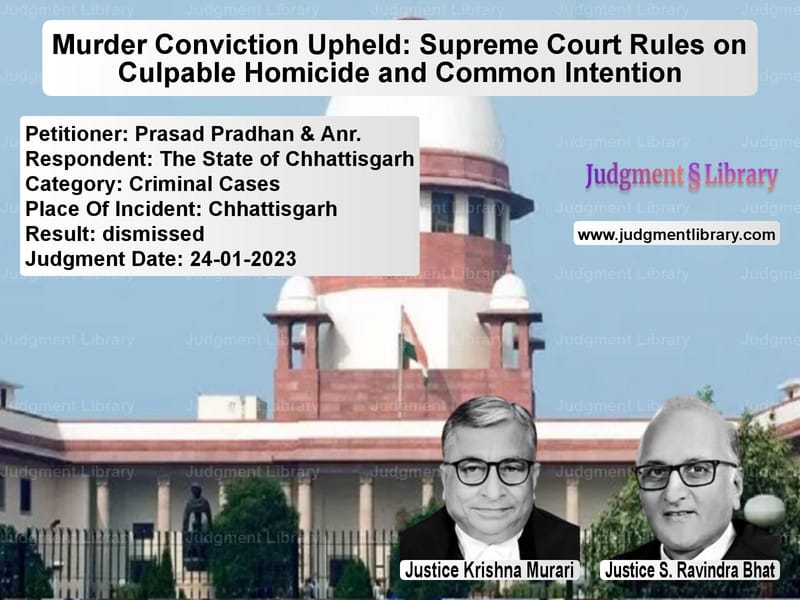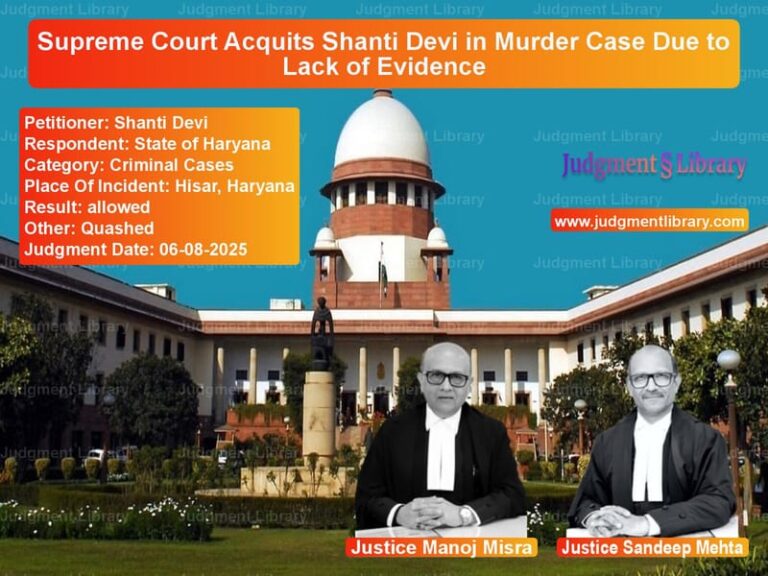Murder Conviction Upheld: Supreme Court Rules on Culpable Homicide and Common Intention
The case of Prasad Pradhan & Anr. v. The State of Chhattisgarh deals with a brutal assault that resulted in the death of an individual due to a long-standing property dispute. The Supreme Court was called upon to determine whether the accused should be convicted for murder under Section 302 of the Indian Penal Code (“IPC”) or whether the offense should be downgraded to culpable homicide not amounting to murder under Section 304 IPC. The ruling provided clarity on key legal distinctions between these provisions.
Background of the Case
The case involved an altercation between the deceased, Vrindawan, and his cousins, the appellants. The dispute escalated when the deceased was leveling his land using a JCB machine. The appellants attacked him with axes, causing severe head and leg injuries. Despite medical intervention, the victim succumbed to his injuries 20 days later. The police registered an FIR under Section 302 read with Section 34 IPC, based on a complaint lodged by the deceased’s daughter.
Legal Issues Considered
The Supreme Court examined the following legal questions:
- Whether the appellants had a common intention to kill the deceased.
- Whether the attack was premeditated or a result of sudden provocation.
- Whether the injuries inflicted were sufficient in the ordinary course of nature to cause death.
- Whether the appellants should be convicted under Section 302 IPC (murder) or Section 304 IPC (culpable homicide not amounting to murder).
Arguments by the Appellants
The defense put forth the following contentions:
- The witnesses were biased as they were related to the deceased.
- The attack was a result of sudden provocation and not premeditated.
- The injuries inflicted were not sufficient to cause death in the ordinary course of nature.
- The victim died due to medical complications 20 days after the incident, which breaks the direct causal link between the attack and his death.
Arguments by the Respondents (State of Chhattisgarh)
The prosecution countered these claims by arguing:
- The accused acted in concert and attacked the victim with weapons, indicating premeditation.
- The testimony of eyewitnesses, including the deceased’s daughter, was credible and consistent.
- The post-mortem report clearly established that the death was caused by the injuries sustained in the attack.
- The accused took undue advantage of the situation and acted in a cruel manner.
Supreme Court’s Judgment
The Supreme Court ruled as follows:
- Common intention established: The Court held that both accused had a shared intent to attack the deceased, making them liable under Section 34 IPC.
- No sudden provocation: The accused initiated the attack without any immediate provocation from the deceased.
- Injuries were sufficient to cause death: The medical evidence confirmed that the injuries were of a nature that would ordinarily cause death.
- Conviction under Section 302 IPC upheld: The Court ruled that the offense was murder and not culpable homicide, given the severity and nature of the attack.
Analysis of the Judgment
This ruling reinforces legal principles related to murder and culpable homicide. The Court emphasized that the classification of an offense depends on factors such as the nature of the attack, the intent of the accused, and the probability of death resulting from the injuries.
Implications for Criminal Law
- Establishes that the use of deadly weapons on vital body parts indicates an intent to kill.
- Reaffirms that pre-existing disputes do not automatically reduce an offense to culpable homicide.
- Clarifies that the time gap between injury and death does not absolve the accused if medical evidence links the two.
Implications for Criminal Trials
- Emphasizes the weight given to eyewitness testimonies, even if they are related to the victim.
- Highlights the importance of medical reports in establishing the cause of death.
Conclusion
The Supreme Court’s judgment in this case upholds the conviction for murder, reinforcing the principle that severe and targeted attacks with lethal weapons leave little room for leniency. This ruling serves as an important precedent for cases involving disputes escalating into deadly assaults.
Petitioner Name: Prasad Pradhan & Anr..Respondent Name: The State of Chhattisgarh.Judgment By: Justice Krishna Murari, Justice S. Ravindra Bhat.Place Of Incident: Chhattisgarh.Judgment Date: 24-01-2023.
Don’t miss out on the full details! Download the complete judgment in PDF format below and gain valuable insights instantly!
Download Judgment: prasad-pradhan-&-anr-vs-the-state-of-chhatti-supreme-court-of-india-judgment-dated-24-01-2023.pdf
Directly Download Judgment: Directly download this Judgment
See all petitions in Murder Cases
See all petitions in Attempt to Murder Cases
See all petitions in Judgment by Krishna Murari
See all petitions in Judgment by S Ravindra Bhat
See all petitions in dismissed
See all petitions in supreme court of India judgments January 2023
See all petitions in 2023 judgments
See all posts in Criminal Cases Category
See all allowed petitions in Criminal Cases Category
See all Dismissed petitions in Criminal Cases Category
See all partially allowed petitions in Criminal Cases Category







